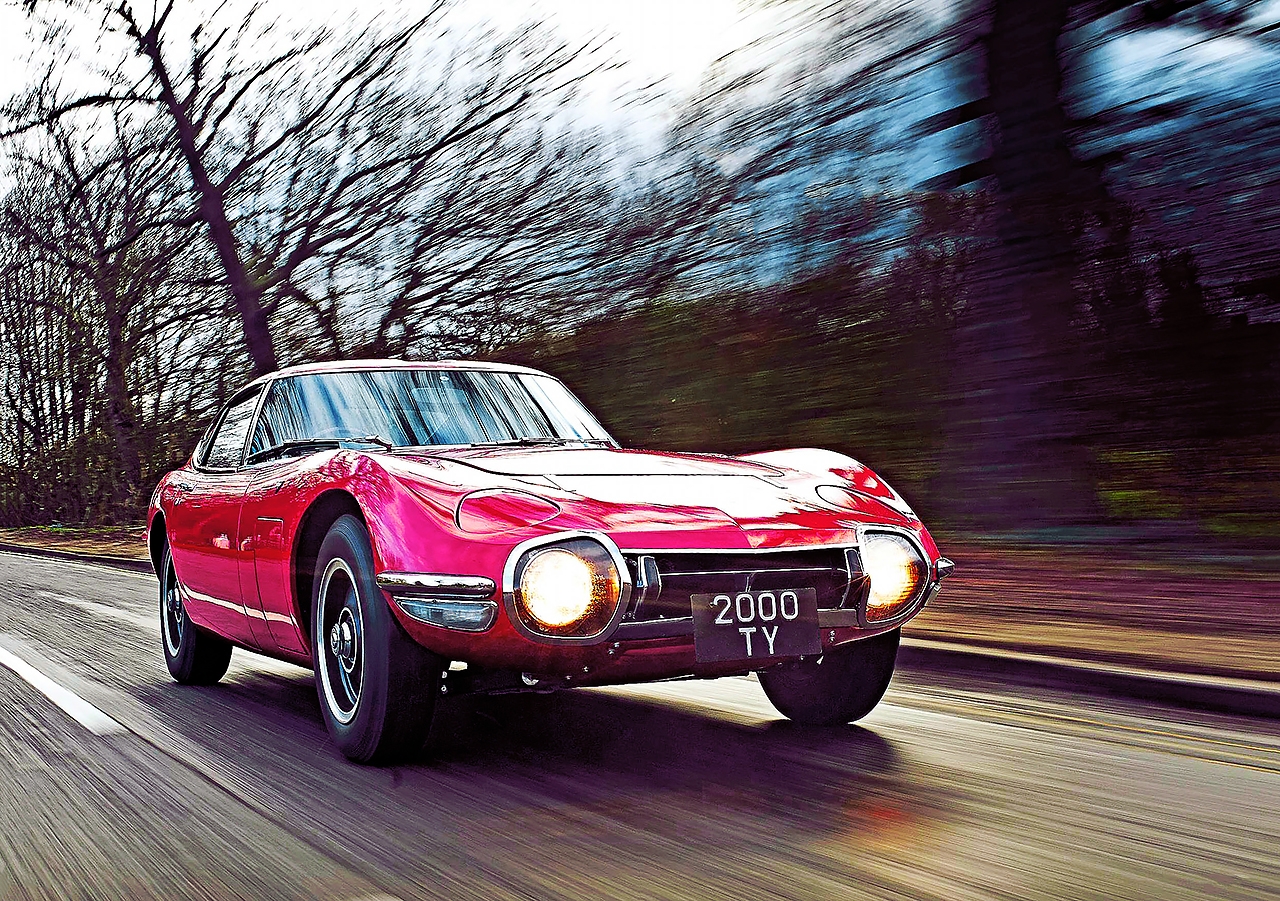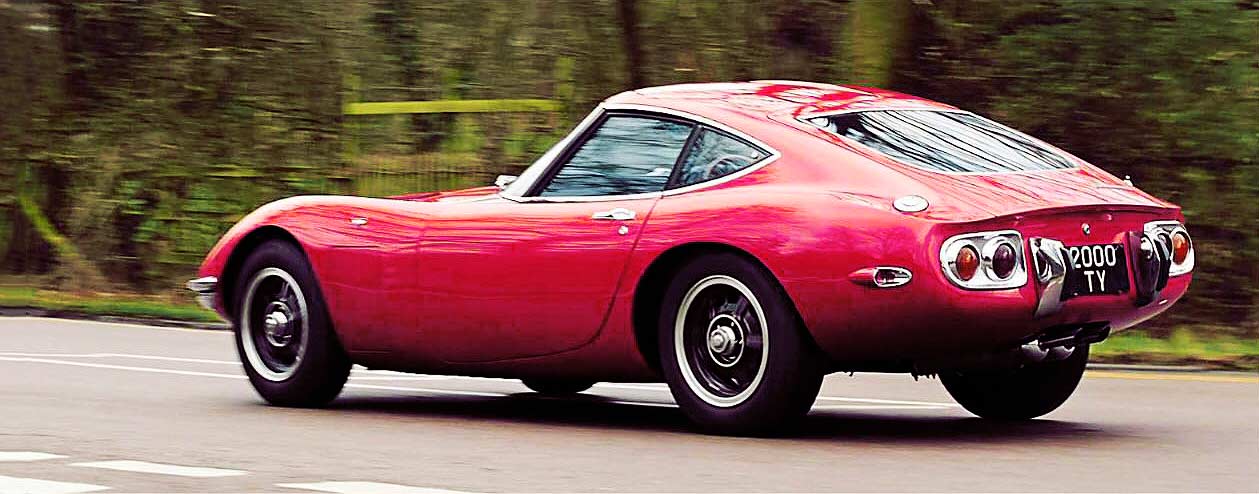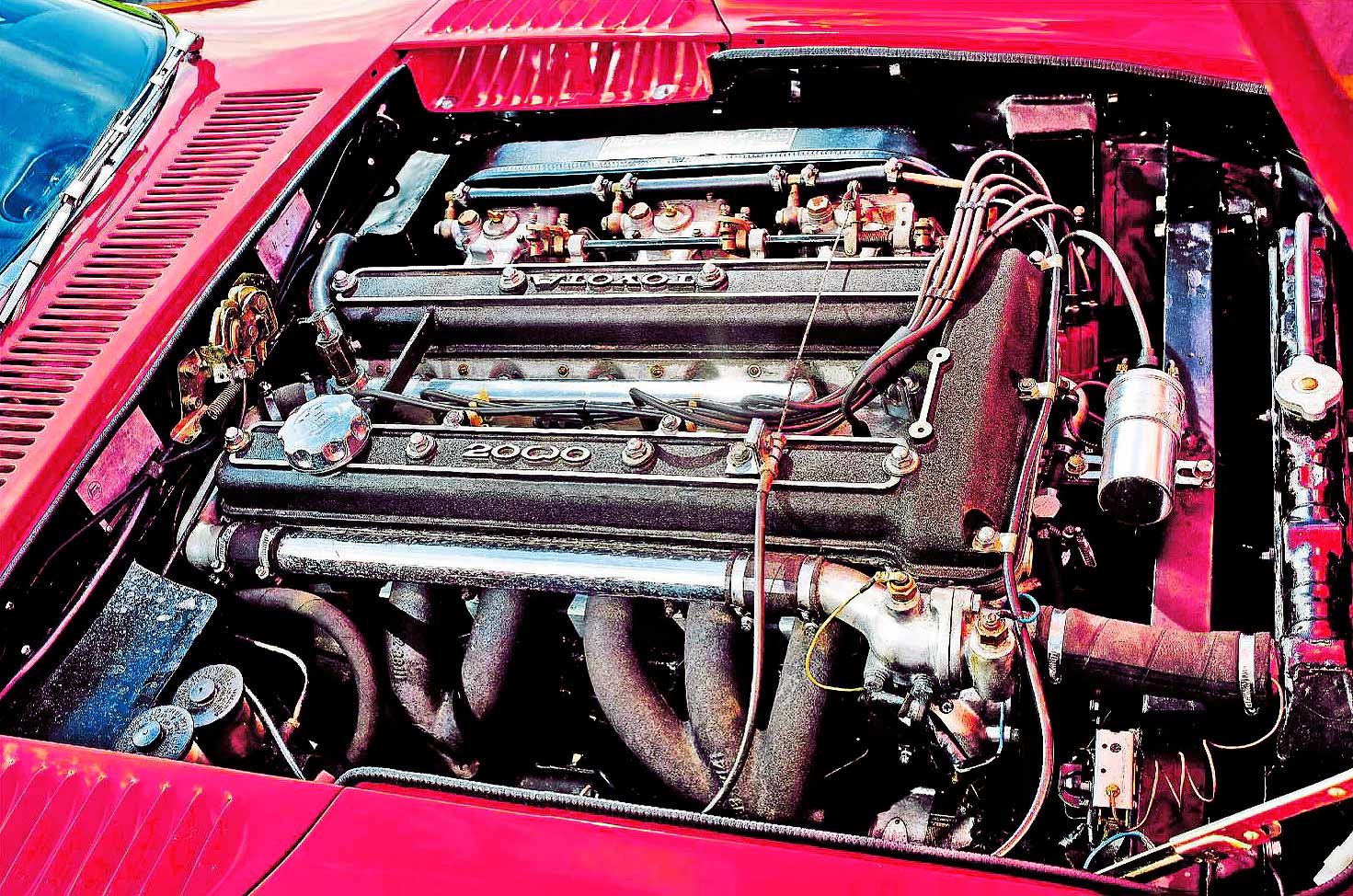
Orient Expression Toyota 2000GT First test after a £150k rebuild. Almost overnight, the beautiful Toyota 2000GT shredded the dull, conservative reputation of Japanese cars. We drive a rare survivor fresh from a £150k restoration. Words Ivan Ostroff. Photography Gus Gregory.
Toyota 2000GT We drive a rare UK-based example fresh from a £150k rebuild Toyota 2000GT Driven
I’m about to drive a Toyota 2000GT for the first time – so I’m having a slow walk around this pretty little machine just to take it all in. Initial impressions are that its dimensions are almost toylike, but in fact it’s only four inches shorter than a four-door Ford Cortina MkII of the same period.

Rear-end tinsel provides a sense of Japanese eccentricity.
The 2000GT’s impressive attention to detail and practicality of design is instantly noticeable. Take, for example, how the battery is so cleverly hidden behind an access panel on the left front wing, while the air filter lives behind a matching panel on the right. It was all packaged to keep the bonnet profile and centre of gravity as low as possible. It’s a job well done – the Toyota is only 5.7in taller than Ford’s all-conquering sports-racer of the same era, the Ford GT40.
As I walk around admiring the sensuous flow of those deliciously curvaceous wings I’m reminded of the old adage, ‘If it looks right, it is right.’ In profile, the Toyota 2000GT’S elegant lines suggest a crossbreed between a Jaguar E-type and a Coke bottle. Note those dainty retractable headlamps that ensure the sweep of the front wings goes unimpeded as the contours rise and fall over the wheelarches. Somewhat typical of Japanese cars of this era, certain details are charmingly over the top. Observe, for example, the convoluted front grille graphic, or walk around the rear end and behold the oversized overriders and chromed light clusters. From this angle, its Sixties Japanese roots become more apparent.
Grasping the elegantly sculpted handle, I open the driver’s door and shoehorn myself into a cockpit that is, in a word, snug. Predominantly designed for the Japanese market, the 2000GT is not particularly receptive to lanky Westerners – but at a mere five-foot-seven, I have plenty of room. In fact, the driving position suits me perfectly (though six-footers would certainly struggle) and the seat feels comfortable and reassuringly supportive. I’ll feel confident when cornering hard.

Weber carburettors were standard-fit items on the competition 2000GTs.
The interior is exceptionally well appointed; there are even individual cigar lighters and ashtrays in both doors. The position of the threespoke wood-rimmed steering wheel is just perfect, as is the stubby gearlever’s polished wooden knob. Clearly the result of collaborator Yamaha’s expertise in pianos, the oh-so-Sixties rosewood veneer dashboard gives an air of class and affluence, while at the same time appearing highly business-like with its full range of clearly marked Jeco instruments monitoring all things mechanical.
The 9000rpm tachometer and 160mph speedometer occupy prime real estate in front of the driver, with five smaller gauges (for fuel level, oil pressure, oil temperature, water temperature and current) in the centre of the dash. The matching clock and time-elapsed instrument sit side by side beneath the original self-seeking radio. The 2000GT wouldn’t meet today’s basic ergonomic expectations, but the gauges are easily readable and cover essential mechanical and electrical happenings, while the switches are perfectly accessible. The seats are trimmed in a high-quality vinyl that convincingly emulates black hide. I twist the key and listen to the 2.0-litre straight-six motor cranking confidently into life. It starts instantly and ticks over smoothly. Although these cars were born with three twin-barrel Solex carburettors, this example is one of many fitted with triple Weber 40DCOEs (as used by the competition variants in period), and I can hear all three taking in great gulps of the crisp morning air.

Sophisticated Toyota relishes the UK’s B-road bends.
The bottom end of the 2000GT’s engine was taken from the Toyota Crown saloon, but its sophisticated double overhead camshaft cylinder head was a specially developed piece of Yamaha craftwork. While the motor settles itself down and warms through, I notice the umbrellatype handbrake that protrudes from the dash; extended out next to my left knee it looks a tad strange, but once I squeeze the grip and allow the shaft to withdraw horizontally into the ornate rosewood panel as it releases its direct grip on the rear discs, it renders itself unnoticed.
With the engine now warmed and idling smoothly, I slide the gearlever forward into first, release the clutch and feel it engage seamlessly as we pull away. As I shift up through the gears gently, it quickly becomes apparent this engine embraces revs – there’s not much activity below 4000rpm.
As the road opens out I begin to experiment. Having accepted that this engine hardly abounds in torque, I’m loving the way it sings and comes alive as the revs climb past 4500rpm and on towards 6000rpm – essentially the exact opposite of the 1.8-litre four-pot in an MGB GT, or the pushrod-six in a 2.0-litre Triumph GT6 of the same vintage. Similar displacements they may be, but such cars were otherwise worlds apart.
With its beautifully engineered bespoke cylinder head and a tight, precise five-speed synchromesh gearbox, the Toyota was certainly more sophisticated mechanically, and the high level of interior trim confirmed it as a rather more upmarket proposition. But it’s only fair to point out that an MGB was about a third of the price of the Toyota.
Under acceleration up a long hill in third gear, the exhaust note is a deep, barking rasp. The Toyota beckons revs, and the box-section backbone chassis (similar to a Lotus Elan) is well up to the performance on tap. Now settled in fifth and cruising at around 70mph there’s hardly any mechanical noise, so I notice how little wind noise there is either. The coilover telescopic-damper suspension is set up to deliver a firm but comfy ride all the way up to the legal limit and beyond.

Interior has an upmarket feel, but leather-mimicking seats are actually vinyl. 2000GTs were built by Yamaha, hence all of that polished rosewood inside. Original magnesium alloys were replaced by aluminium reproductions.
However, country B-roads are where the 2000GT shines brightest. As fast as you would want to be motoring legally the front end will hold grip through any given corner, and the all-round disc brakes knock down the speed confidently. As I push hard on the centre pedal approaching a bend while simultaneously slipping the wooden-topped gearlever into second, I note how agreeably the pedals are placed for blipping the throttle through downchanges while braking.
Because of the lack of torque you need to keep the straight-six buzzing, but once you’re through the 4000rpm barrier, it gets up on cam and you enter a new zone. As the tachometer spins around towards 5000rpm, I hear the three big sidedraught Webers sucking for all they’re worth. Brake, drop down through the silky-smooth box into third, then accelerate out of a bend… the exhaust note becomes a deep, addictive growl and I sense the back hunker down as the rear coil springs take up their load. The braver I get, the more fun the 2000GT seems to become. With initial understeer morphing into very predictable oversteer as I get on the power all four wheels will slide while the car stays perfectly balanced at all times.
Best to avoid lairy tail-slides on a public road… but going into the next corner I try not to turn the wheel so much and get a bit braver with the throttle. The little Toyota loves it and really comes alive; the turn-in is sharp and precise with bags of front-end grip, while the light, direct steering delivers just the right amount of feel. There is relatively little roll and when the independently sprung rear end does eventually let go, a quick flick of the wheel brings everything safely back in line. I can feel those grippy 165×15 Pirellis coping well via the feedback through the wheel, and I know that the chassis is doing its job via the seat of my pants. A rare beauty it may be, but this is also a proper driver’s car.
The more I drive this car the more I’m enjoying it, perhaps because I’m not restricted by the compactness of the 2000GT’s interior as others would be. But its road to production was not quite so direct. When Toyota first revealed the 2000GT at the 1967 Tokyo Motor Show, adorned with fashion model Twiggy, it single-handedly transformed the world view of the Japanese motor industry. Before then, Japan had been known for practical but dull saloons. This curvaceous, elegant fastback showed that Toyota, and indeed the Japanese car industry, could produce an exciting sports coupé – one capable of taking on the best Europe could offer. At the time, Road & Track magazine declared it preferable to the Porsche 911 in many areas.
The original concept for a new GT was styled by Albrecht von Goertz (of BMW 507 fame) when he was working for Yamaha in the early Sixties. Curiously, it was initially envisioned as a replacement for the Nissan Fairlady. However, after seeing the prototype, Nissan opted not to proceed – so Yamaha offered it to Toyota. The Toyota management had already seen a sporting GT as an opportunity to rejuvenate the company’s staid image, and had its own team of designers and engineers create the 2000GT using Yamaha’s facilities. The styling was honed by Toyota’s Satoru Nozaki – the degree to which is a point of contention – and Yamaha’s collaboration included building the cars.

E-type inspiration is clear, but from this angle there’s a whiff of Corvette C3 too.
Due to high-tech features such as the independent all-round suspension and magnesium alloys wheels, the Toyota 2000GT was an expensive proposition at a cost of $6800 (approximately £2700) – particularly when compared to the cheaper Jaguar E-type or Porsche 911 it sought to tempt Western buyers away from. Furthermore, low production capacity at Yamaha’s factory – and Japan’s lack of post-war export experience – meant the 2000GT was only properly exposed to the domestic market, which at that time was simply unaware of the pleasures to be derived from driving a sports car of this calibre.
Ultimately only 337 road cars were built between 1967 and 1970. Considering the Datsun 240Z that that arrived in 1969 was a tremendous worldwide success (albeit at half the price), perhaps the Toyota 2000GT was just that little bit ahead of its time. Sad, as such a delightful little coupé really should have been a greater success.
‘All four wheels will slide while the car stays perfectly balanced.‘
Most people remember the 2000GT for its appearance in the James Bond movie You Only Live Twice, which featured a purpose-built roadster variant. The original plan was to use a standard coupé in the film but its diminutive proportions meant that the 6ft 2in Mr Connery was sized out of the car. Unwilling to give up this heaven-sent marketing opportunity, Toyota agreed to behead a pair of coupés, fitting faux tonneau covers so that they appeared as fully developed convertibles.
Sadly, an open version was never produced for the general market. The 2000GT’s rarity means it’s inherently difficult to find one for sale, and the cult regard with which they’re held in Japan makes it even more difficult to extract them from their homeland. Owner Jane Weitzmann and her late husband Henry bought this 2000GT in 2007 from Japan. ‘We had agreed to buy one through an intermediary,’ she explains, ‘but even though we had sent the money for the car, the guy changed his mind because he didn’t want to see it leave the country.
‘We had to start all over again and find another. We’ve not been able to trace the history of this car in any great detail, but we know that it was in Australia for some time before returning to Japan. Little else has transpired since, but we were delighted to get hold of it nevertheless.’
When the car arrived in UK the new owners were relieved to find it was just as they’d expected – reasonably sound, and needing only light restoration. The shell was in good order but the sills needed replacing. However, the sense of relief soon turned to despair. The company Jane enlisted to restore the car left it exposed to the elements for a prolonged period, causing significant (and frustratingly preventable) damage. When she discovered this it was transferred to Cheshire Classic Cars, where it underwent a bare-metal respray. Only the motor was left untouched, other than being removed for the engine bay to be repainted.
‘It beckons revs, the triple Webers taking in great gulps of crisp morning air’
CCC rebuilt all suspension components and got the car running. It also re-made various chrome parts and body fittings, such as the escutcheons that shield the bonnet hinges, the E-shaped moulding that makes up the front grille and the C-shaped parts on each side of the grille. All these were made from scratch in brass, and then chromeplated. Many of the original decals that adorn various spaces within the engine compartment were copied from a second 2000GT that the company was working on simultaneously.
Although the car had covered 69,000 miles, the interior needed little attention. The rosewood veneer dashboard was refurbished, the seats were retrimmed and the decrepit front mats were replaced. Fortunately, CCC managed to locate some original carpet material and was then able to have perfect substitutes made up. About £150,000 was spent before it was returned to the road but then the cylinder head gasket failed, so it was returned for the head to be skimmed and the valve guides renewed.
In period, the 2000GT was claimed to be the first Japanese car with all-round power-assisted disc brakes. It set several FIA world records for speed and endurance over 72 hours and enjoyed some racing success. It placed third in the 1966 Japanese Grand Prix at Fuji, claimed a one-two at the 1966 Suzuka 1000km (incidentally Japan’s first true endurance race), and won the Fuji 24-hour race in 1967. Carroll Shelby even ran two Toyota 2000GTs in the 1968 SCCA production car races.
In 2013 it became the first Japanese road car to surpass $1m at auction and, although values have cooled off a little more recently, you’ll still have to pay upwards of £400,000 – and that’s if you can find one.
Some referred to Satoru Nozaki’s design as a poor man’s E-type – ironic considering the Toyota was more expensive. But the Toyota 2000GT was not only a fine-looking machine, but also a pleasant-handling driver’s car in its own right.
I’m delighted to have found that out for myself at last.
TECHNICAL DATA FILE Toyota 2000GT
Engine 1988cc Yamaha in-line six-cylinder, dohc, Three Weber 40DCOE carburettors
Power and torque 148bhp @ 6600rpm; 129lb ft @ 5000rpm
Transmission Five-speed manual, rear-wheel drive
Steering Rack and pinion
Suspension Independent, coil springs and wishbones, telescopic dampers
Brakes Power-assisted discs
Length 164.4in
Width 63in
Height 45.7in
Weight 1120kg (2469lbs)
Performance Top speed: 128mph; 0-60mph: 10.5sec
Fuel consumption 30mpg
Cost new $6800 (approximately £2700 in 1967)
Values now £400,000 – £575,000
Jane vows never to sell. OWNING A TOYOTA 2000GT
This car is owned by Jane Weitzmann, who bought it together with her late husband Henry. ‘The attraction of buying this car was the fact that it was beautiful and rather rare,’ she says.
‘Obviously we’d seen the Bond movie [You Only Live Twice]. Also, we already owned a Toyota Sports 800 and liked the idea of that car’s big sister joining it in the stable. ‘It draws amazing reactions from people. If you’re stationary, they’ll pull over to talk to you about the car and take pictures. Henry always wanted one so there are certainly sentimental connections. I can’t imagine ever parting with it.’
When the Weitzmanns bought the car, there was a note on one of the original Magnesium alloy wheels saying it was cracked. So they decided to put the original wheels into storage and replace them with a set of alloy replicas sourced from Japan. ‘I did have an option to acquire another original set, but there was no way of guaranteeing they were crack-free.
I don’t think it’s worth the risk driving at speed on 50-year-old magnesium wheels.’
Some more intriguing discoveries were made during the restoration process – there was front-end crash damage, and a small round orifice in the driver’s door that was found to be the result of a bullet strike. ‘You would most probably crash if you were shot, wouldn’t you?’ muses Jane.





